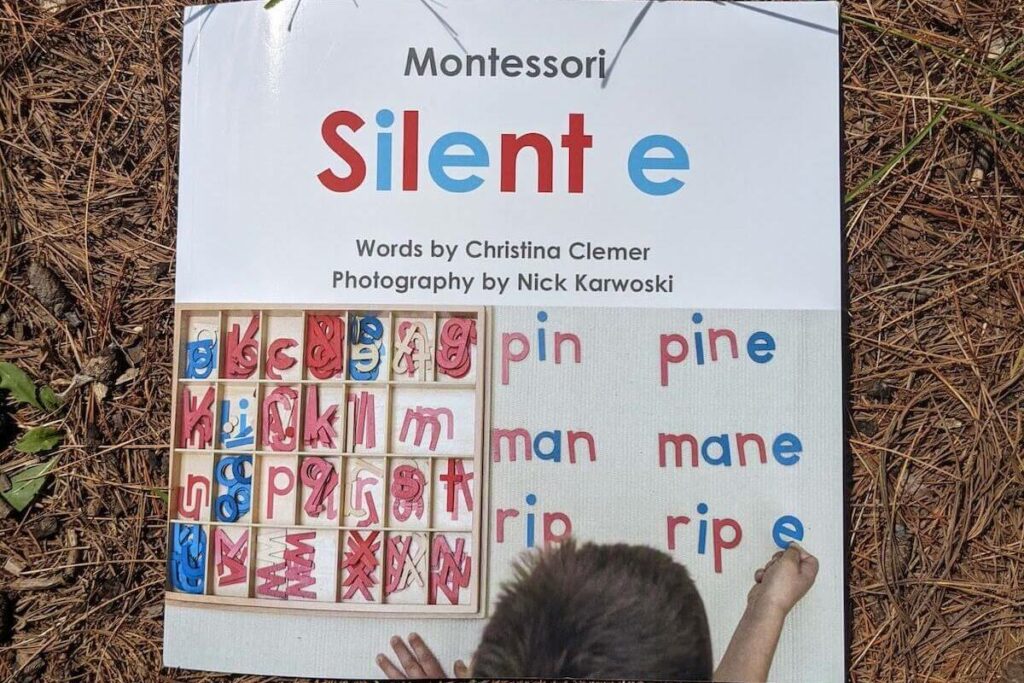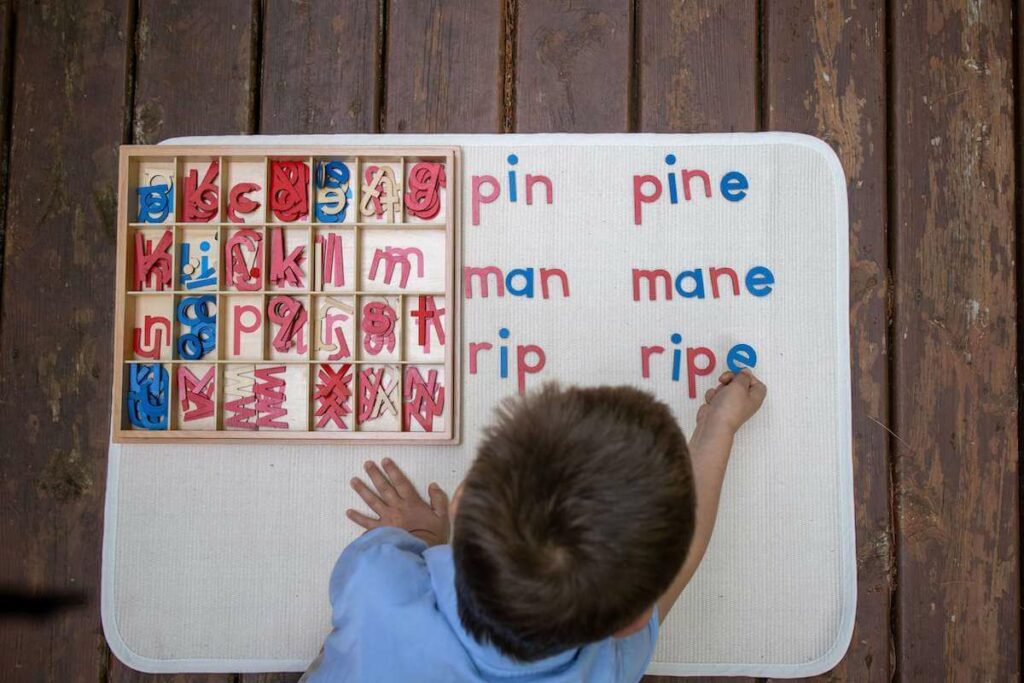
If you’re wondering how to teach silent e or looking for early readers and Montessori language materials, this Montessori Silent e book is a great addition to your resources! Help teach kids to read with beautiful photographic images and clear concepts.
I’m excited to announce we’ve released a new book!
The Montessori Silent e book is perfect for early readers who are beginning to explore long vowels. Similar to our Montessori abc book, it uses simple, photographic images to demonstrate the concept of silent e. It’s designed to spark the child’s imagination and complement other Montessori language materials.
What is Silent e?
If you have no idea what I’m talking about, I’ll back up a bit and talk about silent e.
Also referred to as “magic e,” silent e describes how adding an “e” to the end of a word changes a short vowel to a long vowel sound. For example:
cut >> cute
bit >> bite
man >> mane
This is of course just one of many long vowel concepts that children need to learn. In my experience though, this one is particularly interesting to kids as they enjoy the idea that adding an “e” magically transforms one word into another.
How to Teach Silent e in Montessori

Montessori introduces the concept of silent e through the Movable Alphabet.
Before the child ever learns about long vowels like silent e, they will have used the movable alphabet to practice many phonetic CVC (consonant – vowel – consonant) words and blends (words where two sounds blend together like “slip” or “land”).
When a child has mastered phonetic words and blends, you can begin introducing long vowel sounds, such as silent e.
It’s helpful to first explain what a vowel is. If your child uses the Montessori movable alphabet, this is fairly easy to do as all of the vowels are blue. You can then explain that, in some words, vowels make a different sound. In some words, vowels say their name.
It’s worth noting that Montessori kids learn the sounds, rather than the names, of the letters as this more easily facilitates learning to read. Thus your child may not know the names of the letters. However, I have found that most Montessori children pick up the letter names on their own, without being taught by their teacher, as the abc’s are so prevalent in children’s songs, games, books, television shows, etc.
If you do need to help your child learn the letter names, I like to use the Movable Alphabet for this too. I slowly sing the alphabet song while pointing to each letter. As the letters are in alphabetical order, this is an easy way for a child to figure out on his own what the name of a certain letter is if needed.
Once your child is comfortable with the letter names (or at least the names of the vowels), you can show them how vowels sometimes say their own name (otherwise known as the “long vowel sound”).
For silent e in particular, you can use objects, images or just verbally provide words for your child to build.
First, ask them to build short vowel words that turn into long vowel words when an “e” is added. For example, you might ask them to build, “cut,” “bit” and “man”.
Then add an “e” at the end of each word, explaining how the “magic e” changes the word into a new word. (In the image above, my son is working with the short and long vowel words side by side but for the first lesson, simply add an “e” to the short vowel word. He has already practiced silent “e” many times.)
There’s a great free download with images for this lesson at the end of this post!
I’m also working on a set of cards that corresponds to our book, so stay tuned for those!
What about the Phonogram Movable Alphabet?
If you’re very familiar with the Montessori language curriculum, you may know that a different type of movable alphabet is generally used to teach phonograms (when two letters come together to make a new sound like “ch,” “th,” “ie,” etc.)
For instance, you might use a black movable alphabet for most of the word and a green or a red movable alphabet like this one for the phonogram.
This serves to highlight the phonogram. So if a child is learning the “th” sound, they will clearly see it highlighted in each word that they build.
Some choose to use the single color phonogram movable alphabets to teach silent e, as in this beautifully described lesson.
I used the traditional red and blue movable alphabet for our silent e book for two reasons.
The first is simple. Like most Montessori homeschool families, we have to choose which materials we purchase and which we don’t. We’ve chosen to stick to just one movable alphabet and I use it to show my son phonograms as well as phonetic words.
Second, even when I taught in a classroom, I really found that using the standard movable alphabet upped the “wow” factor for this lesson. If you put a little dramatic flair into it, children really are amazed at how adding an “e” can change one word into a new one. This is easier to demonstrate if you ask the child to build the short vowel words with the standard movable alphabet as they normally would.
How can I use this Montessori early reader book to complement other early readers / materials?

As any Montessori parent or teacher knows, an extension or new material can go a long way toward reigniting a child’s interest in a skill or concept they need to practice.
I recommend introducing silent e through the Movable Alphabet and then introducing this book when your child begins to get the hang of the concept.
I like to read the words from the book to my child and let him build them. He can then use the book to check his own work.
Reading this book with my own son has really helped solidify the concept he’s practiced periodically with the movable alphabet.
Each time you turn the page, you’ll find a short vowel word on the left with it’s long vowel silent “e” counterpart on the right. Each page features photographic images to keep the child’s interest.
You can purchase the book here if you’re interested.
Please don’t hesitate to ask if you have any questions about the book!
What are some other Montessori Early Readers & Montessori reading resources?
- You can read all about our Montessori books and printables here. We have a Montessori abc book and a Montessori Cursive abc book available for purchase. You can read more about them here!
- I haven’t personally tried these but these Silent e Reading Blocks look like a fun extension.
- I wrote an article on 10 Montessori Literacy Activities and another one on 5 Reading Games to play.
- Miss Rhonda’s Readers, early readers written by a Montessori teacher, have been my son’s favorite early readers by far. They have real, interesting stories and are actually fun to read.
- This is a great article on the Movable Alphabet and this one has a fun extension for kids not quite ready to build words, both from How we Montessori.
- This article from Carrots are Orange outlines the progression of Movable Alphabet lessons quite nicely.
- The Kavanaugh Report has a great article with 5 different ways to use the Movable Alphabet.
- This post from Montessori in Real Life explains how the letter sounds are first introduced to the child, what comes before the Movable Alphabet.
This post contains affiliate links. Thank you for your support!